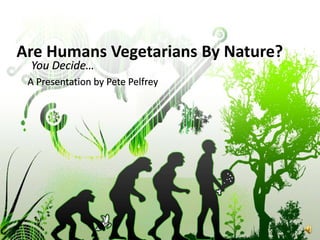
Are Humans Vegetarians By Nature
- 1. Are Humans Vegetarians By Nature? You Decide… A Presentation by Pete Pelfrey
- 2. Statement of Reason Given scientific data on human biology, the theory of evolution, and scientific studies on what are documented as human ancestors from the past and recent history, it stands to reason that humans are herbivorous (vegetarian) by nature
- 3. Biological Overview Humans have longer digestive tracts The teeth and jaw of homo sapiens are just recently starting to adapt to that of an omnivorous diet The jaw, legs, and nails of humans are not strong enough to capture and immobilize prey without the use of tools All flesh-eating animals can naturally digest their prey raw, and crave and consume it without seasoning or preparing it in any fashion
- 4. A satirical vegetarian-geared comic based on many of the prominent biological features humans do not have that other land based carnivores do Artist Unknown
- 5. Digestive Tract Carnivores and omnivores have shorter intestines Natural meat-eaters have larger stomach capacity Stomach acidity in Humans is 20 times weaker than in carnivores Meat needs to digest rapidly, otherwise it will rot inside the intestinal tract Human’s well developed salivary glands are for breaking down fruits, vegetables, and grains Carnivores swallow whole pieces of flesh, and sometimes, entire animals
- 6. Digestive Tract Reference Milton R. Mills, (2009)
- 7. Teeth and Jaw Human teeth are mostly flat for grinding and extensive chewing Humans have a carbohydrate digestive enzyme in their mouth Homo sapiens teeth have adapted more to break down plant material Carnivores have stronger jaws for tearing flesh Reference Lewin and Foley, (2004)
- 8. Teeth and Jaw In the 2004 edition of “Principles of Human Evolution,” Lewin and Foley point out that “Only with the evolution of Homo ergaster (erectus) 1.9 million years ago does the toothwear pattern make a shift, perhaps indicating the inclusion of a significant amount of meat in the diet”
- 9. Teeth and Jaw for Chewing Reference Milton R. Mills, (2009)
- 10. Legs, Jaw, and Nails Mills (2009) asserts that “An animal which captures, kills and eats prey must have the physical equipment which makes predation practical and efficient” Human jaw cannot withstand tearing into natural, unprepared flesh Carnivore nails, or claws, are sharp for helping kill and rip apart prey Humans do not have the leg strength or endurance to constantly chase prey
- 11. Jaw and Nail Structure Reference Milton R. Mills, (2009)
- 12. Early Human Ancestors Eaton and Konner (1985) state that “From about 24 to 5 million years ago fruits appear to have been the main dietary constituent for hominids...since 4.5 million years ago our ancestral feeding pattern included increasing amounts of meat.” The term hominids refers to early cross-evolution species of humans closest to apes Lizard and bug remnants are most commonly found “meat” particles in fossilized teeth from human ancestors
- 13. Modern Human Ancestors The vast inclusion of meat in human diet did not erupt until between the 16th and 18th centuries Meat must be cooked to consume in larger quantities safely, contrary to that of carnivores, which will not consume “cooked” meat in the wild, such as that from a forest fire Develop more diseases and health issues related to meat products than any other dietary item
- 16. Dr. Kellogg maintained that a low protein diet strengthened resistance to disease, promoted longevity, and increased physical and mental endurance; whereas a high protein diet overtaxed the kidneys and liver, and contributed to the accumulation of toxins in the intestines
- 18. Bibliography “The Comparative Anatomy of Eating,” Vegsource, Milton R. Mills, (2009) “Fit Food For Humanity,” Natural Hygiene Press, no author cited (1982) “Teeth of the Earlier Forms of Prehistoric Man,” Arthur Keith (1913) “Paleolithic Nutrition: a Consideration of its Nature and Current Implications,” The New England Journal of Medicine, Boyd Eaton and Melvin Konner (1985) “Principles of Human Evolution,” Roger Lewin and Robert Foley (2004) “The Vegetable Passion,” Janet Barkas, (1975) National Cancer Institute GoVeg.com
Notes de l'éditeur
- which are commonly found in plant-eatersCanines are short, and are more apt for grinding than tearing flesh.
- which are commonly found in plant-eatersCanines are short, and are more apt for grinding than tearing flesh.
- Carnivores caninines are sharp, projected, and do not move side to side for grinding. They are solely in place for tearing fleshEven with evolution from early primates, Enzyme allows for start of plant-material breakdown
- Carnivores caninines are sharp, projected, and do not move side to side for grinding. They are solely in place for tearing fleshEven with evolution from early primates, Enzyme allows for start of plant-material breakdown
- Human nails are blunt, as found in other herbivores
- Increasing amounts were due to shortage and need for sustenance
- Meat started becoming more of a staple with advancing storage methods, seasoning, and ability for humans to afford meat in larger quantities
- Specifically too high in protein, and not enough fruits and vegetables. diseases include heart disease, high blood pressure, stroke, some types of cancer, and diabetes
- Meat is more of a preference in eating than a necessity in our diet